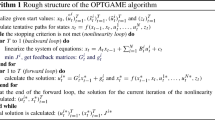Abstract
The interaction of monetary and fiscal policies is a crucial issue in a highly integrated economic area as the European Union. We investigate to which extent the EMU, that introduced a common monetary policy and restrictions on fiscal policy at the national level, benefits from macroeconomic policy cooperation due to the various interactions, spillovers and externalities from national macroeconomic policies. To study the effects of policy cooperation we compare the impact of three alternative policy regimes in a stylized dynamic model of the EMU: (i) non-cooperative monetary and fiscal policies, (ii) partial cooperation, and (iii) full cooperation both in symmetric and asymmetric settings where countries differ in structural characteristics, policy preferences and/or bargaining power. The paper introduces an analysis of coalitional behaviour in a dynamic setting into the literature.
Similar content being viewed by others
References
B. van Aarle, A.L. Bovenberg and M.G. Raith, Is there a tragedy of a common central bank?, Journal of Economic Dynamics and Control 21(2-3) (1997) 417-447.
B. van Aarle, J.C. Enwerda, J.P.E. Plasmans and A.J.T.M. Weeren, Macroeconomic policy interaction under EMU: A dynamic game approach, Open Economies Review 12 (2001) 29-60.
N. Acocella and G. Di Bartolomeo,Wage and public expenditure setting in a monetary union,Working Paper N. 42, Department of Public Economics, University of Rome La Sapienza' (2001).
U. Bindseil, A coalition-form analysis of the allocation of voting rights in the council of the ECB, Mimeo (1996).
U. Bindseil and C. Hantke, The power distribution in decision making among EU member states, European Journal of Political Economy 13(1) (1997) 171-185.
A. Cukierman, Central Bank Strategy, Credibility and Interdependence (MIT Press, Cambridge, MA, 1992).
P. De Grauwe, Monetary policies in the presence of asymmetries, CEPR Discussion Paper, No. 2393, Centre for Economic Policy Research, London (2000).
J.C. Engwerda, B. van Aarle and J.E.J. Plasmans, The (in)finite horizon open-loop Nash LQ game: An application to the EMU, Annals of Operations Research 88 (1999) 251-273.
J.C. Engwerda, B. van Aarle and J.E.J. Plasmans, Cooperative and non-cooperative fiscal stabilisation policies in the EMU, Journal of Economic Dynamics and Control 26 (2002) 451-481.
D. Gros and C. Hefeker, One size must fit all national divergences in a monetary union, CESifo Working Paper, No. 326, University of Munich (2000).
M. Hosli, Coalitions and power: effects of qualified majority voting in the council of the European Union, Journal of Common Market Studies 34(2) (1996) 255-273.
A. Hughes Hallett and Y. Ma, Changing partners: the importance of coordinating fiscal and monetary policies within a monetary union, The Manchester School of Economic and Social Studies 64 (1996) 115-134.
P. Lancaster and L. Rodman, Algebraic Riccati Equations (Clarendon Press, Oxford, 1995).
A. Laruelle and M. Widgrén, Is the allocation of voting power among the EU states fair?, CEPR Discussion Paper, No. 1402, London, UK (1996).
R. Levinsky and P. Silarsky, Voting power and coalition formation: The case of the council of the EU, Institute for Advanced Studies Vienna, East European Series, No. 56 (1998).
R. Neck and E.J. Dockner, Commitment and coordination in a dynamic-game model of international economic policy-making, Open Economies Review 6 (1995) 5-28.
M. Sutter, Voting and voting power in the stability pact, Mimeo, University of Innsbruck (1998).
S.J. Turnovsky, T. Basar and V. d'Orey, Dynamic strategic monetary policies and coordination in iterdependent economies, American Economic Review 78 (1988) 341-361.
M. Widgrén, Voting power in the EC decision making and the consequences of two different enlargements, European Economic Review 38 (1994) 1153-1170.
Author information
Authors and Affiliations
Rights and permissions
About this article
Cite this article
van Aarle, B., Engwerda, J. & Plasmans, J. Monetary and Fiscal Policy Interaction in the EMU: A Dynamic Game Approach. Annals of Operations Research 109, 229–264 (2002). https://doi.org/10.1023/A:1016308420460
Issue Date:
DOI: https://doi.org/10.1023/A:1016308420460




